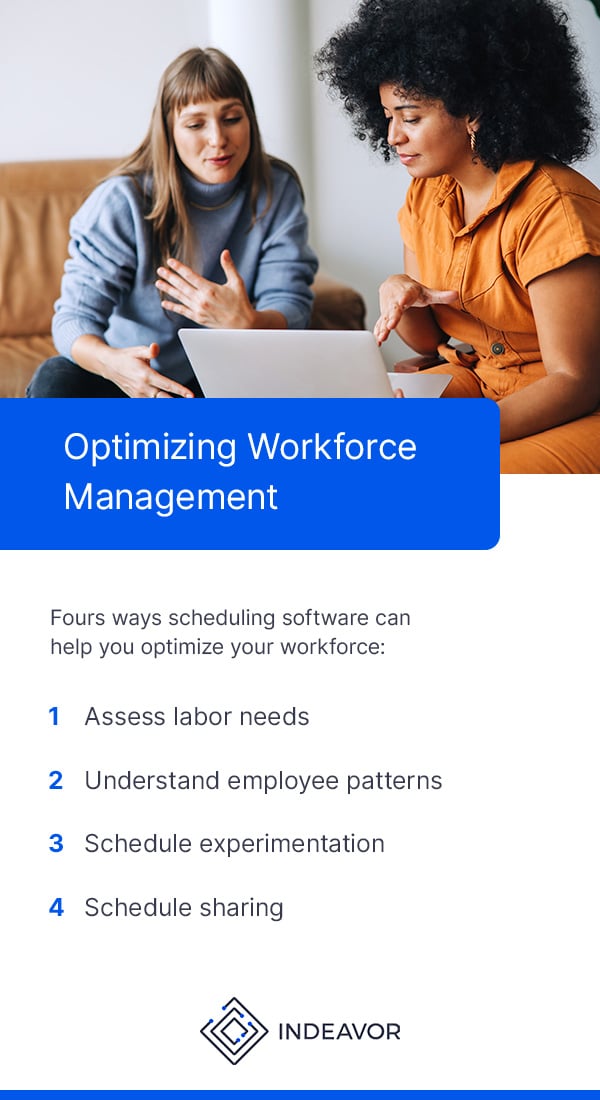Technology is constantly evolving to automate tedious and costly processes. One significant technological advancement is easing the burden of creating detailed schedules for complex industries — automated shift scheduling. Shift scheduling software provides an effective digital solution to shift scheduling, particularly for complex enterprises.
Certain sectors, such as 24/7 industries, are heavily regulated at a federal and state level to ensure the safety of workers while maintaining smooth operations. Other factors, like union agreements and individual business needs, add another layer of complexity to developing fair, flexible, and compliant schedules. Even industries with less detailed and tricky regulations may find scheduling challenging when faced with state and federal labor laws as well as union agreements.
Fortunately, automating the shift scheduling process by implementing the appropriate software benefits all industries. It can help reduce costs and improve workplace safety, industry compliance, and employee satisfaction.
What Is Automated Shift Scheduling?
Automated shift scheduling does precisely what its name implies. It uses automatic scheduling software to develop shift schedules to aid in managing a company’s workforce. This powerful tool reduces reliance on manual scheduling processes such as spreadsheets. Automated scheduling can provide managers, supervisors, and executives with real-time visibility and reporting on schedules, including time off and absences for each employee.
Having a precise understanding of schedules and employee availability helps managers make informed decisions about shift changes to manage any issues arising from unexpected absences proactively. Managers can find the staff with the appropriate skills and experience to fill in for employees who are sick or on leave. These features on a single platform ensure staff scheduling is fair, effective, and accurate.
Features Of Automatic Scheduling Software
Automatic software scheduling constantly evolves and has many features that make workforce management more efficient and effective. Scheduling software can help forecast labor needs, track time, and generate reports. These three features are essential to make managing your workforce simpler.
1. Labor Forecasting
Most workforce management software uses artificial intelligence (AI) and predictive modeling to provide insight into labor needs. It uses real-time and historical data to analyze trends in productivity, labor demands, and staff availability to predict the labor needed by your business at any given time. Being able to predict labor needs can make scheduling significantly easier.
Schedules created based on labor forecasting are not permanent. In the case of unexpected changes in labor demands, alterations to shift schedules are easy to make. Adding or removing staff is relatively simple and you can use the on-hand employee availability data to guide decision-making. Notifications can also be sent immediately to the relative employees who are no longer needed or must cover other employees.
Auto scheduling software can forecast labor needs across multiple locations and create individual schedules based on the unique workforce demands of each site. Notification systems can be set up for the work teams at each location. Ensure the software you choose has cross-device-functionality, allowing employees to access the system on different devices, including mobile phones, tablets or laptops. Being able to submit leave applications and receive notifications on any device ensures work availability is constantly up to date, and notifications can be received anytime.
2. Time Tracking
Time tracking is crucial for proper payroll reporting and proper compliance. Scheduling software tracks how long employees are on a shift, overtime, how many hours they work in a set period, how many breaks they take, and how long their breaks are. It also tracks their vacation time, sick leave and other absences. Tracking time can help identify when you are under or over-staffed.
Time tracking also helps businesses comply with industry, federal, and industry regulations.
3. Workforce Reporting

Reports can be customized and automated using scheduling software and defined based on nearly endless variables and metrics. They can be automated to be sent out daily, weekly, monthly or based on your business’s unique requirements. Reports can cover everything, including hours worked, absences, and shift swapping. All this information can help you make informed scheduling decisions in the future.
7 Benefits of Automatic Workforce Scheduling
Properly and fairly scheduling staff can be a challenging task in any industry. Complex, 24/7-hour industries can make scheduling even more difficult with the need to meet various industry regulations regarding labor and safety requirements. Automated staff scheduling can benefit companies by optimizing costs, improving workplace safety, enhancing compliance, and increasing employee satisfaction.
Here are seven benefits of automatic scheduling software:
1. Reduce Operational Costs and Optimize Your Resources
Automatic scheduling software can help you reduce operational costs and optimizes resource deployment. The data and analytics gathered by the software. Panning shifts and schedules in advance based on historical data on your labor needs can help you avoid over or under-scheduling staff and any unexpected expenses that may arise because of improperly planned shifts.
Overtime costs may also be significantly reduced as shifts are adequately staffed and scheduled to prevent staff from working past their shift hours. Grievances, fines and penalties can also be avoided or limited as compliance and safety improve.
2. Enhances Resource Management
Developing a staff schedule that is fair to all employees and meets all industry regulations can be time-consuming. Hours or days can be spent creating a schedule that meets your business’s various needs may need to be changed suddenly. Scheduling software can be programmed with your company’s specific rules, guidelines, regulations, and employee details before scheduling shifts accordingly.
If staff replacements are needed due to sudden absences, scheduling software can ensure the correct staff is sent based on qualifications and other predefined rules. Further, the longer you use the software, the more data is gathered that can be used to create precise schedules based on your staffing needs.
The software can drastically decrease the time managers spend creating balanced schedules. Instead, managers can focus on engaging with employees, monitoring operations, and attracting new talent.
3. Reduces Human Error in the Scheduling Process
Creating manual schedules often relies on complex systems with lots of paper and spreadsheets that get confusing quickly. Shift scheduling is also an error-prone process. One small mistake can impact weeks of shifts, cause incorrect paperwork that needs updating, and leave you sending updates that may or may not reach employees. Auto-scheduling software can help reduce human errors, as many processes are automated. It also uses historical data on productivity levels to create a well-balanced schedule.
Schedule updates immediately register and are communicated directly to appropriate staff. If a schedule needs to change for any reason, you can avoid potential clashes with relief staff, as the system can notify managers if an employee is already scheduled, has met their required hours for a set period, or are unavailable because they are sick or on leave. These automatic notifications can save time spent comparing leave requests and existing schedules.
Scheduling software can usually be integrated with existing payroll and reporting systems. Automatically updating schedules with staff overtime is also more straightforward and accurate, decreasing inconsistencies in payroll and reporting. Seamlessly transferring data, including adding or removing time, can streamline payroll systems.
4. Improve Employee Work-Life Balance

Flexible work arrangements and a work-life balance have become increasingly important for employees in all industries. The desire for work-life balance is especially crucial in the face of growing labor shortages in complex industries, such as nuclear power and manufacturing.
Automatic scheduling software can help your company accommodate the changing needs of employees by ensuring shifts ensure a proper work-life balance. Staff can view their shifts, apply for leave, and request shift changes on their phone or laptops. Having full access to schedules improves scheduling fairness and transparency. It can set your company apart from others in your industry as you build a reputation for ensuring a proper work-life balance.
Other advantages to improving work-life balance include:
-
- Lower absenteeism and presenteeism rates.
-
- Fewer unwanted shifts.
-
- Improved employee satisfaction.
-
- Reduced employee turnover.
-
- Fewer union grievances.
5. Increases Employee Productivity
Scheduling software can help increase your productivity in various ways. Shifts are less likely to be under or over-staffed, which can significantly improve productivity. Having over or under-qualified employees assigned to jobs and specific shifts can lead to boredom or mistakes that could hamper productivity. The teams scheduled will have the proper balance of qualified and experienced team members to ensure operations run smoothly.
Improved work-life balance and proper fatigue management can improve employee focus and energy levels, improving overall productivity. Managers and supervisors will also have more time to focus on other aspects of their job when they don’t have to spend considerable time developing and monitoring schedules. Instead, they can monitor work performance and find ways to improve operations.
6. Ensure Fatigue Management Compliance
Fatigue management is crucial in many 24/7 industries like the oil, gas, and nuclear sectors. They are also heavily regulated to ensure employees are safe and well-rested when working in these potentially hazardous roles. These regulations dictate the length of shifts, how often they can be scheduled for specific shifts, and the required rest periods between shifts. All of these regulations are challenging to navigate and make creating a compliant schedule more difficult.
Automated scheduling software can be programmed with predefined rules based on your industry’s regulations before creating a schedule. Setting up these rules beforehand ensures your schedules are compliant, helping you avoid fines and penalties for noncompliance.
In addition, state and federal laws and labor union agreements regarding meal and break laws can also make compliance more difficult, especially as many states and labor unions have their own break rules. These laws can even vary according to factors such as industry, age of workers, number of people on a shift, and shift length.
Employee certification and training can also be monitored more effectively. Employee data, including qualifications, must be added to the system to help develop schedules. Once loaded, they are easily accessible and monitored for expirations. Employees can then go for retraining or certifications to remain compliant and up to date with the latest industry innovations and best practices. Scheduling software can even notify managers and supervisors if break and rest periods are missed.
7. Improve Workplace Safety
Automated staff scheduling can considerably improve workplace safety by reducing fatigue and enhancing staff performance. Well-rested staff can prevent accidents by being more likely to avoid harmful or costly mistakes. They are also more likely to make clear, rational decisions when faced with emergencies and other challenges.
Having qualified, skilled, and experienced staff assigned to each position can also ensure the workplace is safer. Their skills and experience can prevent accidents before they occur by working effectively and efficiently. They can also swiftly manage and deal with any issues before they become greater problems.

Using automatic scheduling can be used to optimize your workforce management. Several variables need to be considered when managing a workforce. Software can help address many of these variables.
Here are fours ways scheduling software can help you optimize your workforce:
- Assess labor needs: Every business has unique labor needs. Each department and piece of equipment has different requirements in terms of skills and training. Understanding these needs ensures companies hire the right talent and deploy them correctly.
- Understand employee patterns: Knowing when your employees are available, their absenteeism patterns, and their shift preferences is vital to improving workforce management. This information can be leveraged to create schedules and contingency plans that reduce absenteeism and understaffing.
- Schedule experimentation: Scheduling can be challenging and may take several iterations before finding a schedule that suits employees’ needs and ensures optimal productivity. Experimenting with schedules is essential when you first start implementing automated scheduling software. The software will need time to gather data that can be used to design effective schedules.
- Schedule sharing: Schedule transparency ensures staff knows precisely when they are scheduled or are possible backups for unexpected absences. Most software has cross-device functionality that lets teams access their schedules, apply for leave, and request shift changes. Free and easy access can help prevent over or under-staffing.

Improve Workforce Management With Indeavor’s Scheduling Software
Complex industries need scheduling software that can keep up with their needs. Indeavor creates scheduling software that leverages intelligent algorithms to handle labor needs and shift the development of even the most complex industries. Our automated scheduling software is purpose-built for complicated regulations and aids in developing schedules that consider all your business needs, from employee availability to the various regulations you may need to comply with.
Create rules tailored to your company’s unique requirements that consider various factors, including employee seniority, availability, qualifications, and labor demands, when creating schedules. One of our dedicated customer success managers will work with you to develop predefined rules tailored to your company. Everyone from managers and executives can access the schedules and receive notifications about any shift updates as they occur.
Our software can also easily integrate with existing systems to streamline workforce management and scheduling. Book a demo today to learn how our scheduling solutions can benefit your company.







